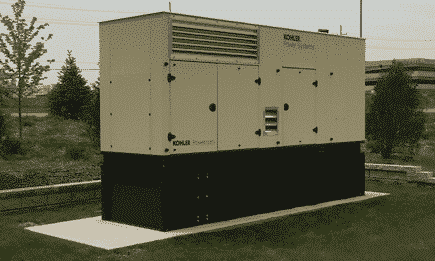This is the initial phase when installing a new industrial generator. You will need to consider:
- Calculating Power
During the pre-installation phase of your project, you need to start by calculating the power required for your building or facility. Power requirements vary greatly from industry to industry, from small 35 kW commercial generators as backup power for specific pieces of equipment to large 2500 kW power plant installations for water treatment plants, data centers, factories, hospitals, university campuses, etc. At Woodstock Power, we’ve spent decades cultivating strong relationships with power generation experts around the country. Together we’ll work with them to determine your power needs — either primary, backup or both — and choose the right industrial generator for your requirements. - Planning Your Concrete Pad
Once you know which type and size of generator, it’s time to plan for the right concrete pad. A concrete pad is specific to the shape, size, footprint and weight of your generator. An undersized pad can cause many problems, including:- Insufficient space to safely install your generator
- Inadequate room for access and maintenance
- Overloading of your pad, leading to cracking
- Legal and regulatory noncompliance and possible fines or generator shut down
Take the time to study your concrete pad foundation design and plan for a high-quality pad that is adapted to the size and position of your new industrial generator. Our team at Woodstock Power can help you find a reliable contractor who specializes in concrete pad and foundation design no matter where you are in the country. These experts have advanced foundation thickness calculators that will allow them to determine the perfect thickness of concrete for your generator pad to avoid cracking.
In many cases, your generator concrete pad specs will also require vibration insulators. These ensure vibrations created by your generator are not transmitted into your facility where they can disrupt sensitive equipment and your employees. A concrete foundation design calculation will allow your pad contractor to assess the vibration specifications of your generator and account for this with the right concrete pad and insulator design.
- Containment Tank
All power generators require a containment tank to ensure all fuels and lubricants are contained and are not able to leak onto the floor or ground. Leaking fluids present a health and safety risk to your employees and the environment in and around your facility. Once the design of your concrete pad is established, it’s time to design a suitable containment tank.Industrial generator containment tank design includes the following factors:- Size: The tank needs to be large enough to allow installation, operation and service of your generator
- Volume: The tank needs to be able to contain the fluid and fuel on your generator in case of leakage
- Strength: The tank needs to withstand the weight and operating conditions — vibration, temperature, etc.
- Compatibility: The tanks needs to withstand the chemical nature of your generators fuel and/or lubricants
Your generator installation contractor can help you determine the best type and size of containment tank for your generator. Consider including a storage area for any fuels, fluids and lubricants you’ll be using with their own containment tank. It’s important to check all local and federal laws on safe chemical storage and respect all guidelines for containment, ventilation and fire detection and suppression.
Site Planning
The next step before creating your concrete generator pad and installing your new generator is taking care of additional site planning requirements. These steps are necessary to ensure your generator is installed in a safe manner that respects the health and safety of your employees and the maintenance personnel that will run and service your generator.
The site planning phase will usually include:
- Barriers: Plan for safety barriers to block access to your generator and ensure that general employees and visitors to your site can’t access your generator. Barriers can be fences, bars, posts, walls or complete enclosures. In all cases, you will need to include a lock that only authorized personnel can open.
- Sounds suppression: Depending on the size and power of your generator, you may need to include sound suppression around your industrial generator. Check local workplace noise regulations to determine the acceptable levels and determine if you need to isolate your generator from your building to reduce noise.
- Safety alarms and fire detection: Depending on where you install your diesel generator, you will need to include various safety alarms and detectors for exhaust, heat and fire. You may also be required by state and federal law to include fire suppression equipment, such as sprinklers, for safety compliance.
These are just a few of the site planning factors you need to consider before installing a new industrial generator. Complete this step before creating your concrete pad design to ensure that all barriers are compatible with your pad foundation shape, location and construction.


